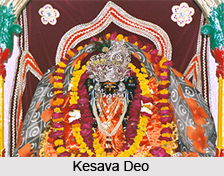 Kesava Deo Temple, an ancient Hindu temple revered by pilgrims from different places, is located close to the main Krishnajanmabhoomi complex in Mathura in the Indian state of Uttar Pradesh that happens to be the birthplace of Lord Krishna. The presiding deity of the temple is Lord Krishna installed in the sanctum sanctorum or "Garbhagriha" of the temple. The Lord is worshipped in the form of Kesava Deo. It is also known as Krishna Janmasthan temple.
Kesava Deo Temple, an ancient Hindu temple revered by pilgrims from different places, is located close to the main Krishnajanmabhoomi complex in Mathura in the Indian state of Uttar Pradesh that happens to be the birthplace of Lord Krishna. The presiding deity of the temple is Lord Krishna installed in the sanctum sanctorum or "Garbhagriha" of the temple. The Lord is worshipped in the form of Kesava Deo. It is also known as Krishna Janmasthan temple.
History of Kesava Deo Temple
It is believed that the original deity of the temple, the idol of Lord Krishna, was established by Bajranabh along with the construction of the first temple, who was said to be the great grandson of Krishna. The historical records suggest that the next big religious edifice was constructed during the reign of the Gupta Empire (320 to 550 CE) by the emperor Chandragupta II. Following this, the temple was demolished and reconstructed again over time. In 1661 C.E it was however destroyed by the Mughal ruler Aurangzeb. Later the temple was re-constructed and the idol was installed.
 Present Kesava Deo Temple
Present Kesava Deo Temple
Kesava Deo Temple is run by a trust which includes an illustrated list of Trustees including the family members like Swami Vamdevji Maharaj, Swami Akhandananda Saraswati, Anantashayanam Iyengar and Ganesh Vasudev Mavalankar. The temple has its own festival calendar and observes almost all the Hindu celebrations in its premises including Krishna Janmashtami, Chhappan Bhog, Lathamar Holi and others. A huge idol of Lord Krishna made of marble stands in the middle of the sanctum sanctorum. Besides this, smaller idols of Krishna, Radha, and Balarama are installed. There is a small prison like room within the temple complex besides the temple where it is believed that Lord Krishna was born. It has a raised platform which marks the exact birth spot of Lord Krishna. Numerous devotees pay their reverence by touching the slab. Various mythological paintings and verses of Garbha Stuti adorn the walls of the prison. This site has also been under the excavation works which started in the year 1953 under the chairmanship of Swami Akhandananda.
Visiting Information
Kesava Deo Temple is a prime attraction of Mathura and can be conveniently reached. Nearest airport is located in Agra at a distance of about 60 kilometres whereas nearest railway station is Mathura and Vrindavan. Mathura also has a good connectivity of roadways which connects it with other major cities of India.





















